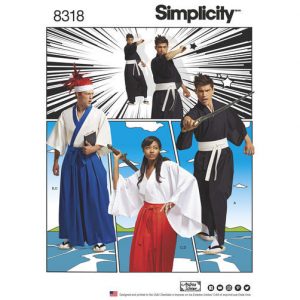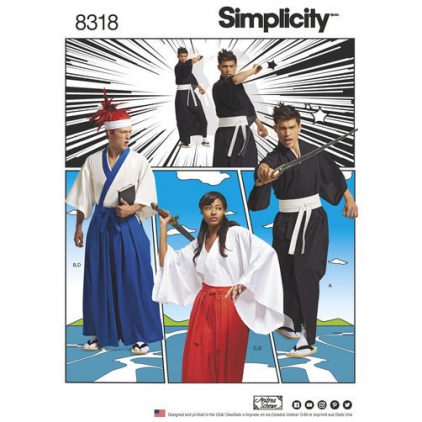Pattern makers have made kimono patterns in the past. One I remember in particular was a kimono from a Halloween line. I purchased it at Walmart on clearance with the genuine hope that I’d get my way through the directions and make a kimono… however, that pattern was plagued with seams and other headaches that are not consistent with a true kimono. It was also difficult to follow so I ended up tossing it into my box of shame. Once again I find myself intrigued, this time by a much plainer packaged and less intimidating pattern.
 Here are the specs:
Here are the specs:
Skill level: Intermediate
Sizes: XS – XL
Pattern number: 8318
Upon first glance at the instructions, this pattern can be intimidating. Not only is it not 100% accurate (most kimono patterns are not) because it involves building a kimono with what looks like 6 panels instead of 3, you’ll need a small collection of interfacing for many of the details. Compared to other kimono patterns I have seen, this one definitely looks like a walk in the park. You only need to worry about 14 pattern pieces in total and some you won’t even need depending upon which design you’re working on. You’ll also realize there are as many steps as there are pattern pieces. You can have a kimono in 13 steps and hakama pants in another 13. That’s not bad when you consider how many panels and steps go into making a fitted bodice or other smaller garments. Unfortunately, if you already know how to make a kimono the Japanese way, this pattern has too many steps and too many pieces. Of course, if you do choose to go rogue and follow a more accurate pattern, you’ll be pained in the wallet when you realize how much fabric you need to purchase since Americans don’t have the wonders of buying small bolts of fabric cut specifically for making kimonos and yukatas.
Since Simplicity split up the kimono into several panels, this actually saves you some money because you can purchase a little under 3 yards of fabric for a long kimono if you’re a size small and even less for the shorter variations. When I made my kimono the ‘traditional way’ with as few panels as possible, I needed 8 yards of fabric. A lot of that fabric got wasted as I trimmed the kimono to size. The hakama pants will run you a little more money at over 4 yards of depending on how wide the fabric is but you definitely won’t need 8 yards.
The directions are the same for 3 variations of the kimono so once you master the pattern, you’ll be busting out cool cosplays in no time. Just looking at the photos on the envelope gives you a great idea of which characters this will work with. And if you want to be fashionable at your Japanese Jiu-jitsu class, you can probably get away with wearing patterns B and D if you use the right colors and fabrics.
If you have your own way of making a kimono by now like I suspect most cosplayers do, then that’s dandy. Even if you do, Simplicity 8318 is great for the hakama pants, which you’ll definitely want for a few cosplays or real life escapades. I’m not particularly an elitist when it comes to Japanese fashion so I don’t mind if there is an extra seam here and there – especially if it saves me money and a yard of fabric.
*This item was provided for review.


